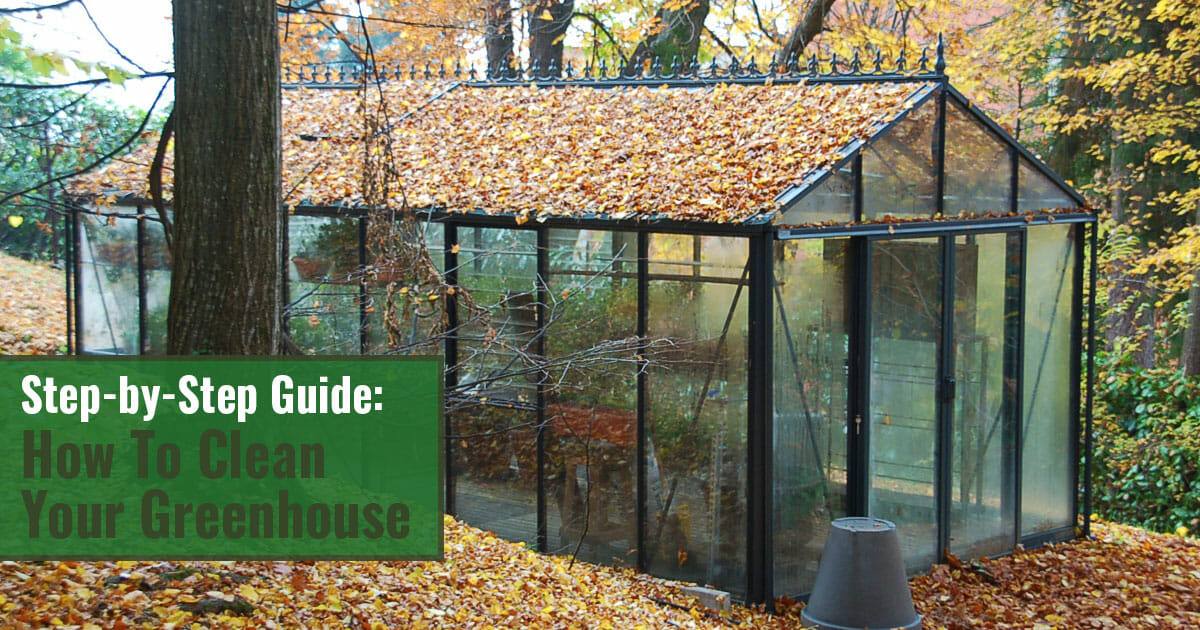

It’s very essential to keep your greenhouse clean because it prevents unwanted pests and diseases, as well as guarantees proper light conditions. However, it takes more than just hosing down the whole structure.
If greenhouse gardening is still new to you, you might be wondering how often you have to wash your greenhouse. In fact, you’ll also need to know how to clean your greenhouse. Note that the procedure for polycarbonate greenhouses may not entirely apply to glass greenhouses. But the good thing is, you’ll get the chance to learn all of the greenhouse cleaning basics from this article.
While it’s essential to know how to clean your greenhouse, you should also understand why it is so important.
Why should you clean your greenhouse?
I know, cleaning your greenhouse may not be the most exciting task but it is a very important one. Clean panels let more sunshine through which maximizes the productivity of the plants. All plants need light for photosynthesis. Especially in the winter, this can be crucial. When days are already short and the sun hits the greenhouse at a different angle, they can use all the sunlight they can get.
The main reason why you want to keep your greenhouse clean is to prevent pests, algae, and various diseases from affecting your plant’s growth and maybe even causing them to die.
While a greenhouse offers a great environment for plants, it also provides ideal conditions for certain pests. Tiny insects will thrive wherever you give them a chance, this is why a routine clean-up of your greenhouse is vital.
The cracks and crevices provide hibernation ground for insects. Plus, you’ll still have to deal with plant pathogens living in the soil. Algae will grow on the lines and gnats will reproduce on organic residues.
Last but not least, you have invested some money into a greenhouse. In order to get the most out of it, maintenance chores, such as cleaning, should be part of your annual gardening schedule. Thankfully, some seasons are perfect for that.
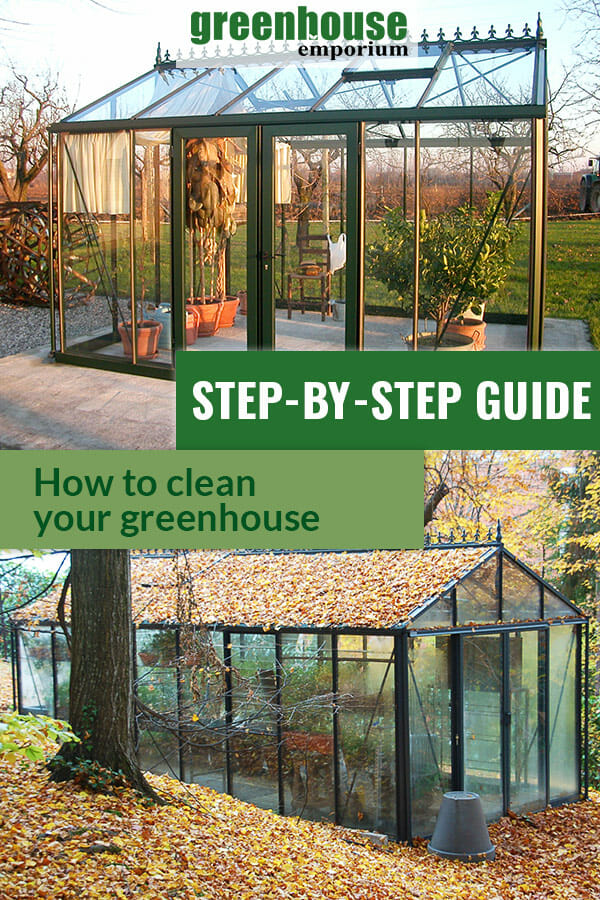
When to clean your greenhouse
In addition to the regular maintenance of your greenhouse, you can develop a yearly cleaning routine. We encourage you to schedule it in your calendar so you don’t forget it.
Everyone uses a greenhouse differently but you will have times when you have fewer plants or when you just harvested a lot of produce. This is generally when you should exploit the opportunity of a less crowded space and get the cleaning done.
For a lot of gardeners, this opportunity opens up in fall or in the wintertime. This is mostly because fewer crops are thriving at this time or you are about to start your spring crops.
Cleaning the greenhouse before you start your fresh seedlings would be ideal! If you are picking fall or winter, you need to choose a mild day so that any overwintering plants can be safely placed outside for a while.
Some gardeners concentrate on growing outdoors in summer so that their greenhouse is mostly empty during that season. This means that the end of summer will be another opportune time (again: before you start new seedlings)!
Besides the fact how full your greenhouse is, you’ll need to take in consideration what plants have to wait outside while you are performing the chore. Maybe you’ll have delicate plants that cannot cope with cold temperatures. This means you shouldn’t wait for the cold days, you should get it done earlier instead.
- For delicate year-round plants, such as orchids: clean in mild spells in fall
- For summer crops, such as tomatoes: clean in winter when the crop has been removed
- For periodic and successive crops, raising seedlings: clean in periods between crops such as fall or spring
How to clean your greenhouse in 5 easy steps
Let’s start with the general steps and then we’ll dive into cleaning glass and Polycarbonate panels explicitly.
What you will need:
- Broom and/or rake
- Bucket
- Mild (biodegradable) dish soap, such as Grab Green’s* or Mrs. Meyer’s Clean Day’s* dish soap
- Glass cleaner
- Disinfectant, such as Charlie’s Soap*
- Vinegar
- Sponge, maybe even a car wash mop with pole (like this one on Amazon*)
- Squeegee window cleaner tool with a telescopic pole, such as this one on Amazon*
- Microfiber towels (or any window drying towels)
- Water hose
- (Step) Ladder – height depends on your greenhouse (you need to be able to reach the top with your tools)
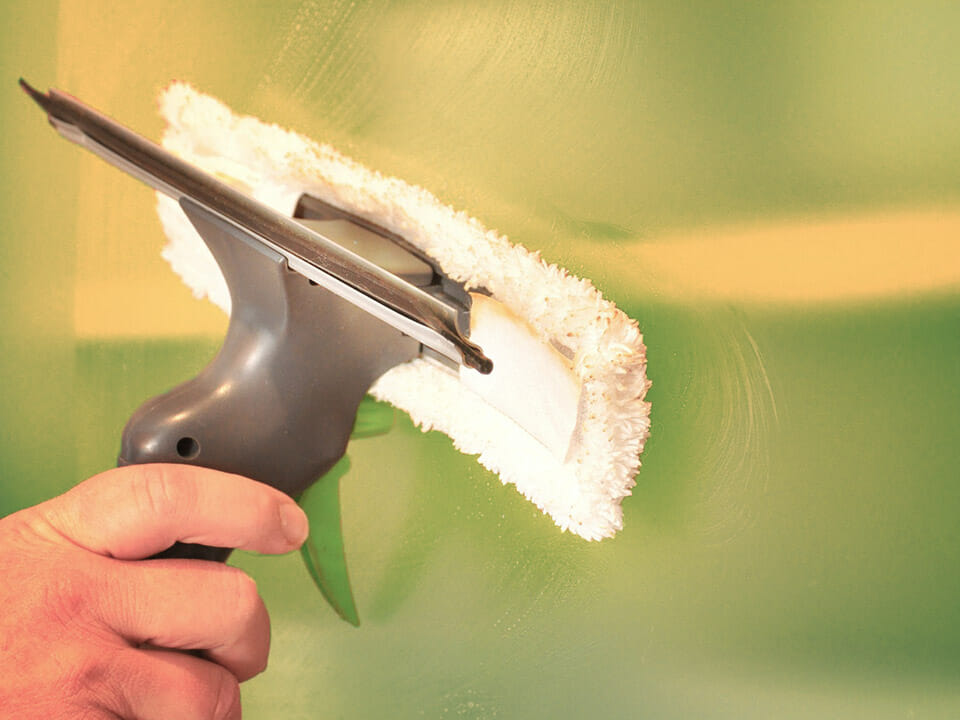
Step 1: Empty your greenhouse
Empty your greenhouse completely. If necessary, cover plants while storing them outside or take them inside your house or garage.
You should also detach as many accessories as possible, for example, shade cloths, plant hangers, watering systems, grow lights, etc.
Step 2: Sweep and brush your greenhouse
Brush down the framework and shelving to remove leaves, dirt and plant scraps. Then sweep the floor if you have a concrete slab, wooden deck, or similar flooring. If you have soil, you should rake the leaves and plant remains.
Try to remove unwanted scraps as much as possible. This can go a long way because it prevents pathogens and diseases from infecting healthy plants.
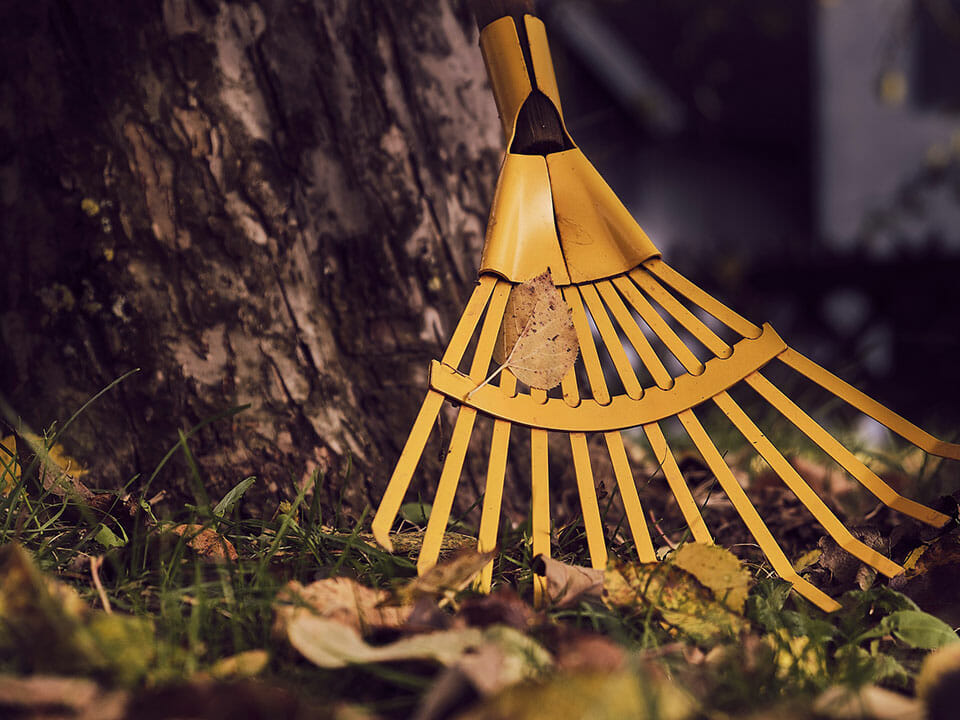
Step 3: Removing leaves from gutters & empty rain barrels
Take time to check for leaves and debris in your gutters. Remove them so it doesn’t block the pipes. This is especially important after the trees have lost their foliage in fall.
Empty the water butts and then rinse them in order to get rid of the accumulated dirt at the bottom. Use an oxygen bleach solution to scrub the inside and rinse it. This way no algae can build up in the following season.
If you are living in a climate with freezing winter temperatures, this will be a great time to uninstall and store the rain barrel for the winter. This means you should do this step before the first freeze.
Step 4: Cleaning the greenhouse framing and glazing
Both the inside and outside of your greenhouse needs cleaning. No matter what glazing you have, you should use a (step) ladder to reach the top of your greenhouse.
Use dish soap and a sponge or brush (not too hard) for scrubbing the framing. Don’t use a brush if you have a Polycarbonate greenhouse, though. In this case, definitely use a non-abrasive sponge.
If you have wood framing, the last thing you want is wood rot or pests. They love to hide in the cracks of wood frames. So, you want to apply a non-toxic vegetable-based horticultural oil to all sensitive wood areas. A brush will be perfect for this task, it’ll help you cover any areas that unwanted pests could be hiding in.
You also have to pay attention to the gaps. Sometimes it’s hard to clean them. Be creative, utilize old toothbrushes or other tools!
We will go into more detail how to clean glass and Polycarbonate panels below.
Step 5: Clean pots, seed trays, and other accessories
Ensure you wash pots, planters, and seed trays with warm soapy water. You can also use disinfectant as well. Use 3/4 cup of oxygen bleach for one gallon of water. After a few minutes of soaking, rinse the equipment thoroughly and dry it with a clean towel.
Also, wipe down shelves and other surfaces with a scouring sponge. Then you can return everything to the proper place and organize everything perfectly.
If you are using internal or external shade cloths, it’s time to wash them.
You should also consider cleaning your irrigation system. It can develop algae and become a ground for unwanted bacteria and fungi. This is likely to happen if you irrigate your plants from a nearby pond. Ensure you disinfect all parts of your irrigation system to prevent contaminating your plants and soil. This procedure is vital, you don’t want to water your plants with infected water.
If you can remove the watering heads, do so, and soak them in a vinegar-water solution. It’ll decalcify them and make them look as if they were new.
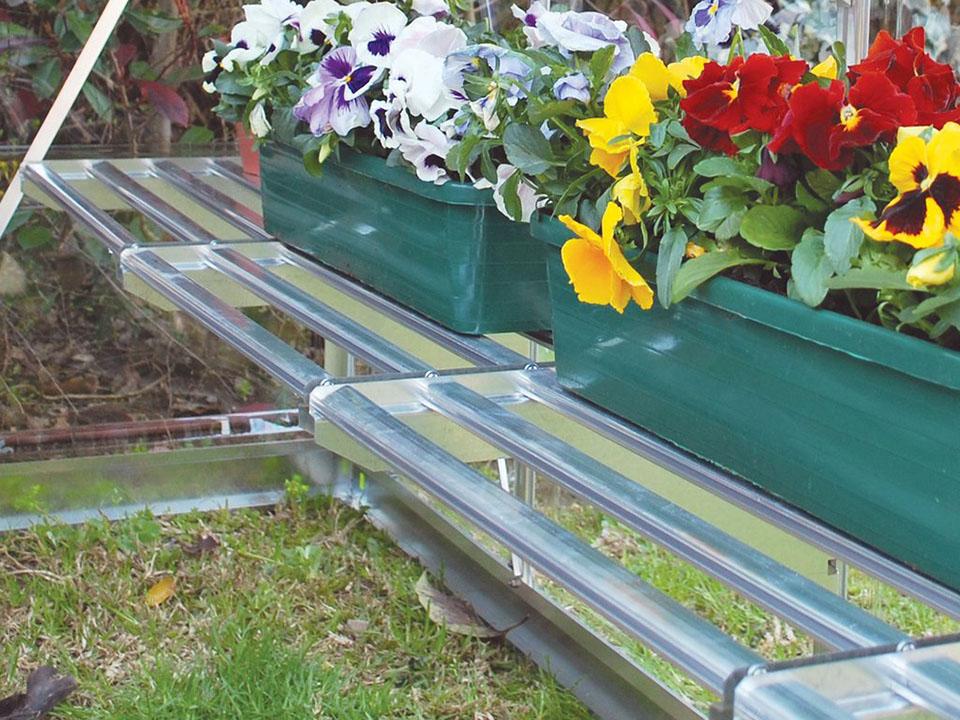
How to clean glass greenhouses
If you are used to cleaning windows, this won’t be new for you. It just brings the burden of hard-to-reach areas, such as the center of the roof.
If you want to keep your glass greenhouse looking good, you may have to perform this cleanup more often than once a year. Water leaves stains which will eventually make the glass rather milky. Especially hard water, accelerates this effect.
Here are the steps to clean your glass panels:
- Hose your greenhouse to get the major dirt and dust off.
- Get a bucket with soapy water and lather your greenhouse in it. You can use a window squeegee tool, car wash mop, or sponge. This step can be skipped if the rinse already took most of the dirt away.
- Now, rinse off the soap with a hose.
- Mix a glass cleaner solution in a bucket. If you have lots of water stains you can use vinegar as well. Utilize the scrubber/sponge part of the squeegee tool to apply the solution. Maybe let it soak for a bit if you have big problems with water stains. Then dry it with the squeegee and maybe use a microfiber towel for any leftover water drops.
How do you clean a Polycarbonate greenhouse?
Polycarbonate is different from other glazing materials. It offers several benefits but it scratches a little easier. So, you want to pay attention to the materials used in cleaning it.
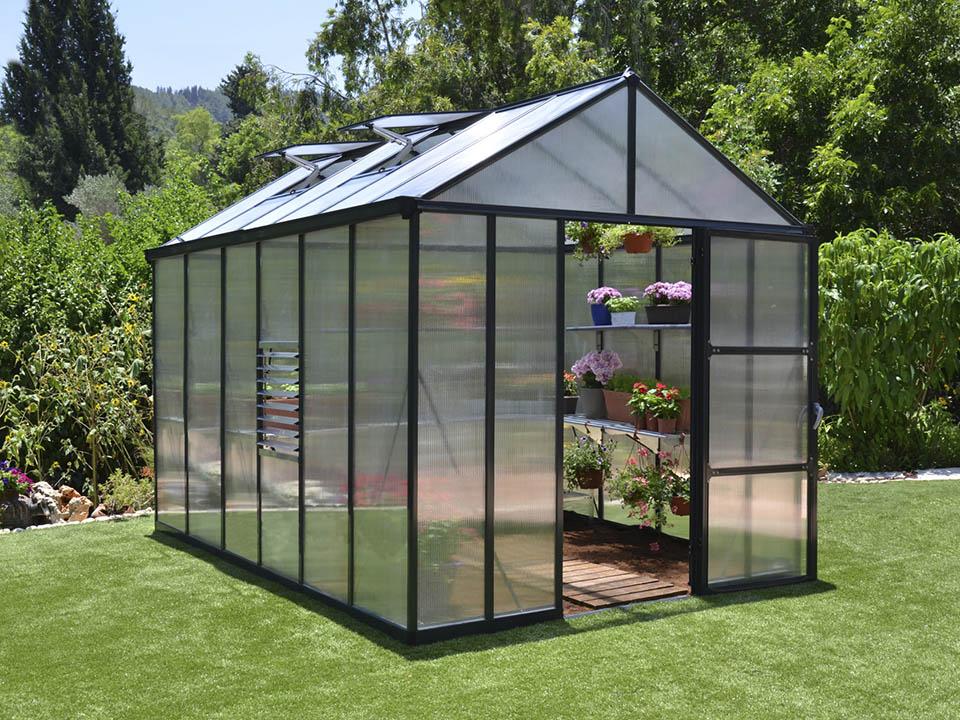
What to use to clean a Polycarbonate greenhouse
You don’t require any fancy solution to clean up your Polycarbonate walls. You can easily use a mild soap such as a liquid dishwashing soap. Most Polycarbonate items have UV protection, so you cannot scrub them or use harsh abrasives when washing them.
And then, most other household cleaning products contain at least one chemical that can damage the coating on your Polycarbonate panels. Plus, you’ll need a non-abrasive sponge so that you don’t damage the material.
How to clean your Polycarbonate greenhouse
- Simply mix a few drops of dish soap in a bucket of water. You are going to clean the inside and outside with it. I’d start with outside and then continue inside.
- Gently wash the Polycarbonate sheets with a soft sponge or car wash mop. These mops are perfect because they are gentle and often have telescopic poles so you can lather the whole greenhouse easily.
- Depending on how dirty the greenhouse is, you may have to go over it one more time after letting it soak in for a bit.
- Proceed to rinse the walls with a water hose until the soap is gone.
- Dry them with a fresh soft towel or a new dry mop to avoid water stains.
Preventative measures
Besides the annual cleanup, you should always keep your greenhouse as clean and tidy as possible. The best preventive measure remains daily or weekly cleaning of your greenhouse. A couple of minutes every week will make a significant difference. It prevents pests and diseases and it’ll make it easier to do the big cleanse. So, regularly get rid of plant remains and sweep/rake your greenhouse.
If you are dealing with hard water, you may want to increase the frequency of cleanups. This way it’s easier to get rid of water stains and lime build-up in watering systems.
Replace old soils with clean disease free soil. Old soils might contain diseases and pathogens, and you really don’t want that.
As a preventive measure, properly space your plants apart. Be mindful of whatever you are taking into your greenhouse, pests, and diseases can be transferred from several items. Always practice good hygiene by disinfecting your tools.
Taking the time for greenhouse cleaning at the season’s end will save you time and energy. You can relax knowing that any crops entering the greenhouse the next year will have a better chance to survive and thrive.

